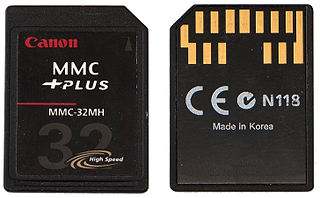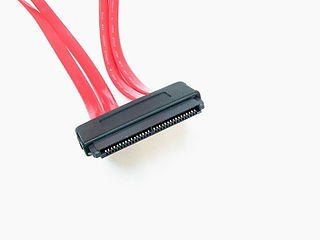
Parallel ATA (PATA), originally AT Attachment, also known as Integrated Drive Electronics (IDE), is a standard interface designed for IBM PC-compatible computers. It was first developed by Western Digital and Compaq in 1986 for compatible hard drives and CD or DVD drives. The connection is used for storage devices such as hard disk drives, floppy disk drives, optical disc drives, and tape drives in computers.

Industry Standard Architecture (ISA) is the 16-bit internal bus of IBM PC/AT and similar computers based on the Intel 80286 and its immediate successors during the 1980s. The bus was (largely) backward compatible with the 8-bit bus of the 8088-based IBM PC, including the IBM PC/XT as well as IBM PC compatibles.

Small Computer System Interface is a set of standards for physically connecting and transferring data between computers and peripheral devices, best known for its use with storage devices such as hard disk drives. SCSI was introduced in the 1980s and has seen widespread use on servers and high-end workstations, with new SCSI standards being published as recently as SAS-4 in 2017.

SATA is a computer bus interface that connects host bus adapters to mass storage devices such as hard disk drives, optical drives, and solid-state drives. Serial ATA succeeded the earlier Parallel ATA (PATA) standard to become the predominant interface for storage devices.

Zero insertion force (ZIF) is a type of IC socket or electrical connector that requires very little force for insertion. With a ZIF socket, before the IC is inserted, a lever or slider on the side of the socket is moved, pushing all the sprung contacts apart so that the IC can be inserted with very little force - generally the weight of the IC itself is sufficient and no external downward force is required. The lever is then moved back, allowing the contacts to close and grip the pins of the IC. ZIF sockets are much more expensive than standard IC sockets and also tend to take up a larger board area due to the space taken up by the lever mechanism. Typically, they are only used when there is a good reason to do so.

CompactFlash (CF) is a flash memory mass storage device used mainly in portable electronic devices. The format was specified and the devices were first manufactured by SanDisk in 1994.

Secure Digital, officially abbreviated as SD, is a proprietary, non-volatile, flash memory card format the SD Association (SDA) developed for use in portable devices.

MultiMediaCard, officially abbreviated as MMC, is a memory card standard used for solid-state storage. Unveiled in 1997 by SanDisk and Siemens, MMC is based on a surface-contact low-pin-count serial interface using a single memory stack substrate assembly, and is therefore much smaller than earlier systems based on high-pin-count parallel interfaces using traditional surface-mount assembly such as CompactFlash. Both products were initially introduced using SanDisk NOR-based flash technology.

Self-Monitoring, Analysis, and Reporting Technology is a monitoring system included in computer hard disk drives (HDDs) and solid-state drives (SSDs). Its primary function is to detect and report various indicators of drive reliability, or how long a drive can function while anticipating imminent hardware failures.

A disk enclosure is a specialized casing designed to hold and power hard disk drives or solid state drives while providing a mechanism to allow them to communicate to one or more separate computers.

In computing, Serial Attached SCSI (SAS) is a point-to-point serial protocol that moves data to and from computer-storage devices such as hard disk drives, solid-state drives and tape drives. SAS replaces the older Parallel SCSI bus technology that first appeared in the mid-1980s. SAS, like its predecessor, uses the standard SCSI command set. SAS offers optional compatibility with Serial ATA (SATA), versions 2 and later. This allows the connection of SATA drives to most SAS backplanes or controllers. The reverse, connecting SAS drives to SATA backplanes, is not possible.

The USB mass storage device class is a set of computing communications protocols, specifically a USB Device Class, defined by the USB Implementers Forum that makes a USB device accessible to a host computing device and enables file transfers between the host and the USB device. To a host, the USB device acts as an external hard drive; the protocol set interfaces with a number of storage devices.
ATA over Ethernet (AoE) is a network protocol developed by the Brantley Coile Company, designed for simple, high-performance access of block storage devices over Ethernet networks. It is used to build storage area networks (SANs) with low-cost, standard technologies.

Direct-attached storage (DAS) is digital storage directly attached to the computer accessing it, as opposed to storage accessed over a computer network. DAS consists of one or more storage units such as hard drives, solid-state drives, optical disc drives within an external enclosure. The term "DAS" is a retronym to contrast with storage area network (SAN) and network-attached storage (NAS).
This table provides summary of comparison of various flash memory cards, as of 2024.
Spin-up refers to the process of a hard disk drive or optical disc drive accelerating its platters or inserted optical disc from a stopped state to an operational speed. The required operational speed depends on the design of the disk drive. Typical speeds of hard disks have been 2400, 3600, 4200, 5400, 7200, 10000 and 15000 revolutions per minute (RPM). Achieving such speeds can require a significant portion of the available power budget of a computer system, and so application of power to the disks must be carefully controlled. Operational speed of optical disc drives may vary depending on type of disc and mode of operation.

A Serial ATA port multiplier is a device that allows multiple SATA devices to be connected to a single SATA host port. Many common controllers do not support this feature, as it is not a requirement for a SATA controller.
NVM Express (NVMe) or Non-Volatile Memory Host Controller Interface Specification (NVMHCIS) is an open, logical-device interface specification for accessing a computer's non-volatile storage media usually attached via the PCI Express bus. The initial NVM stands for non-volatile memory, which is often NAND flash memory that comes in several physical form factors, including solid-state drives (SSDs), PCIe add-in cards, and M.2 cards, the successor to mSATA cards. NVM Express, as a logical-device interface, has been designed to capitalize on the low latency and internal parallelism of solid-state storage devices.

ATAPI is a protocol used with the Parallel ATA (IDE) and Serial ATA standards so that a greater variety of devices can be connected to a computer than with the ATA command set alone. It carries SCSI commands and responses through the ATA interface.
Hard disk drives are accessed over one of a number of bus types, including parallel ATA, Serial ATA (SATA), SCSI, Serial Attached SCSI (SAS), and Fibre Channel. Bridge circuitry is sometimes used to connect hard disk drives to buses with which they cannot communicate natively, such as IEEE 1394, USB, SCSI, NVMe and Thunderbolt.













